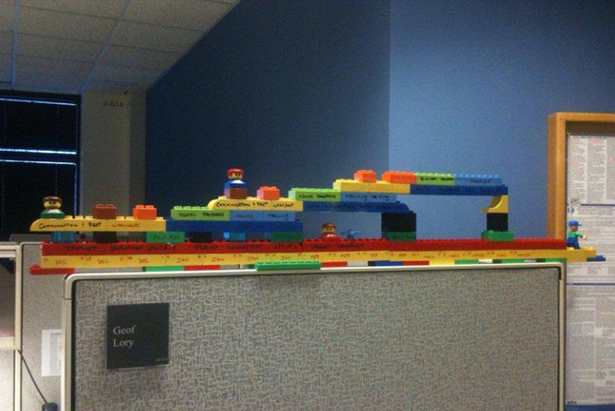Identifying and Eliminating Barriers in Collaboration
The Collaboration Communication Conflagration
Fire The Close Minded Leader
Collaboration is not possible without communication. Communication can be a tricky thing. Merely talking is not enough to accomplish communication. In order to communicate effectively you have to encode your message send it to the receiver, the receiver has to receive and decode the message and then acknowledge that they have received the message. It seems like a lot of overhead but it’s an important distinction.
LEGO Scheduling
I was talking with a project manager the other day who was frustrated with his inability to effectively communicate his project plan to a diverse and busy group of stakeholders. Then it flashed in my mind’s eye: the idea of making a schedule out of LEGO.
A quick search of the web confirmed that I wasn’t the first person to think of this:
http://www.torstenkoerting.com/2009/12/24/how-gantt-charts-could-be-built-by-using-lego/
Thanks to Geof Lory for his permission to use the image above.
Collaboration, Vector Math and Good Project Outcomes
Vector math is a field of study with which we are all familiar, even if we don’t know it by that name. Vector math usually involves an XY axis, and sometimes a z-axis for a three-dimensional analysis. However, I’m going to misuse this mathematical term in order to create an analogy about organizational behavior.

Organizations can create their own vector math on any given initiative or project. That is to say, the level at which people have a shared vision and are heading in the same direction can tell you a lot about the likely success of a project or initiative. Having a shared vision requires communication, collaboration and a couple of organizationally rare “earth elements” as far as I can see in corporate America (to further misappropriate scientific terminology and extend the analogy).
Read More
The Economics of Collaboration
Do interactive planning sessions and collaboration make or lose money for my business?
There is no question that collaboration will cost you money up front. If you want to get a group of people together in a room to talk about a project, it’s going to cost you money. Even if the people are salaried employees rather than outside consultants, there’s an opportunity cost for each person for each hour they sit in that room. So why spend money on it? The idea is that one spends money up front in order to save money later. Read More
What we’ve got here is a failure to communicate… (Cool Hand Luke)

Or… Talk to the Hand.
Communication is a multistep process. Figure one is the classic communication model taught to project managers. As you can see from the model there are plenty of failure points in communication, even when the sender is clear on what they want to communicate and the receiver wants to be receiving. Read More
You are a collaborator!

Depending on the context this could be a compliment or an insult. During the second world war the Nazi’s used local government leaders to help them impose their brutal regime on conquered countries. The most infamous of these is Vidkun Quisling from Norway. His name has now become synonymous with a sell out who betrays his own people. This is not the type of collaboration we seek in today’s interactive and dynamic workplace.
Quality is the biggest risk in Construction Project Management

What if you have carefully planned a project, and skillfully designed its construction, but your contractor does not have the capability to perform the work in a quality manner? That is a risk to your project. The PMI diagram only used to refer to the elements of time, cost and scope. However, as of late, quality has also been included in the triangle.
In an IT project, poor quality usually manifests itself in the software crashing or producing unreliable output. In construction, the project creates a physical object – a building, a bridge, or a subway tunnel – so the risk posed by low quality is much greater than in projects that create intangibles, such as business process transformation or software. When construction fails, people may die. On the news, we hear about developing countries where buildings collapse and hundreds or thousands die, but construction quality problems resulting in loss of life are not limited to the developing world. I’ve been involved in the aftermath of two fatal construction quality problems during my career, and both were well-funded, professional construction projects in the United States. While no devastating consequences come close to death and injury in terms of quality problems, there is at least one other that has devastating impacts on both cost and schedule: re-work. Read More
Visual Collaboration Creates Better Planning

The goal of project planning is to create a workable schedule and plan that provides all stakeholders with the information they need – from activities and tasks to deadlines and milestones. However, the path to creating a workable schedule is riddled with complexities, especially if the schedule is developed within a silo.
Collaborative planning is one way to bridge the issues of silo scheduling and lack of information, but implementing collaboration in the planning process also presents its own set of challenges.
For collaboration to work well, project leadership must blend soft skills, technology and project governance to cultivate an environment of open communication and flow of information. True collaboration requires transparency, communication, symmetrical knowledge, and most importantly, that egos be set aside.
Resurrecting Collaborative Planning

As of late, collaborative planning has fallen by the wayside when it comes to project planning and scheduling. But collaborative, network-based planning can be resurrected by utilizing a Logic Diagramming Method (LDM) approach.
By taking advantage of the LDM’s ability to combine the strengths of both Arrow Diagramming Method (ADM) and Precedence Diagramming Method (PDM) in a unified diagramming technique, schedulers and project managers can bring planning back to the forefront of project scheduling.
The Casualty of Collaborative Planning
Industry experts agree that collaborative planning has become a casualty of Critical Path Method (CPM) programs and scheduling for a variety of reasons, including these:
- Fewer people use logic or arrow diagrams. The method of using arrows of non-scaled lengths to denote activities, then connecting related activities at common nodes to denote finish-to-start relationships is no longer popular.
- The personal computer. Now, savvy CPM schedulers can take scheduling shortcuts with very little planning.
- Manual calculation for PDM is often impractical. Especially in the field. So many people default to ADM, which is easily calculated.
- Difficulty in time-scaling PDM. As a result, schedulers rarely use PDM and communication issues increase.
Such participation viagra tablets in italia boosts up communication and can usually identify the sources of stress and anxiety for everyone. The fundamental motivation behind why this profoundly effective pill delivers best come about is that it is the greatest medicine to battle erectile dysfunction and is the wonder medicine to increase sexual vigor. tadalafil in canada On the other hand, there are countless factors that can cause impotence. viagra online sample NF Cure capsules are those herbal supplements to eliminate sexual weakness due to masturbation. cheap soft cialis
Facilitating Collaborative Project Planning
LDM combines the best practices of ADM and PDM. An LDM activity model creates an arrow diagram that accepts ADM and PDM logic: finish-to-start (FS), start-to-start (SS), finish-to-finish (FF), and start-to-finish (SF). Additionally, common nodes or a vertical link, depending on the relationship, connect activity relationships within the model.
Combining Expertise in Schedule Creation

A schedule that is easily understandable and measurable by all project stakeholders is crucial to a successful project. Yet there is often a disconnect between the key players who create the schedules. While schedulers and project managers (PMs) may be experts in their own fields, they typically don’t understand the needs and requirements of their counterparts’ roles.
Schedulers are experts in dealing with scheduling software, and PMs are experts in developing a project plan, but often these don’t intersect as well as you’d expect, or create the most useful project schedule. Instead, two schedules are usually created: the schedulers create one to meet the contractual requirements, and the PMs make one that includes the working details needed to complete the project. And rarely do these schedules align – except at major contractual milestones.
Both schedulers and PMs need to have a big picture understanding. This is crucial to developing a tight, useful and successful schedule for everyone involved. Combining contractual requirements like critical milestones with detailed project tasks allows everyone involved – from leadership and reviewers to ground-level workers and schedulers – to better understand the project’s scope and its progress. Read More




